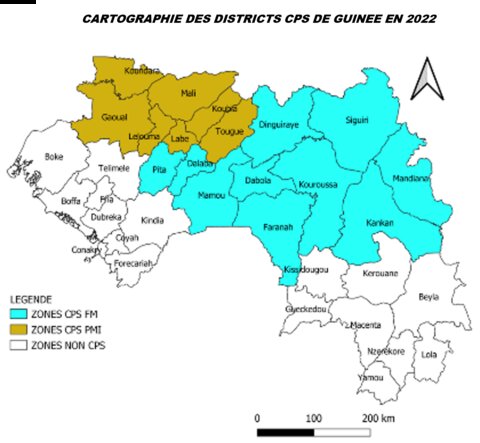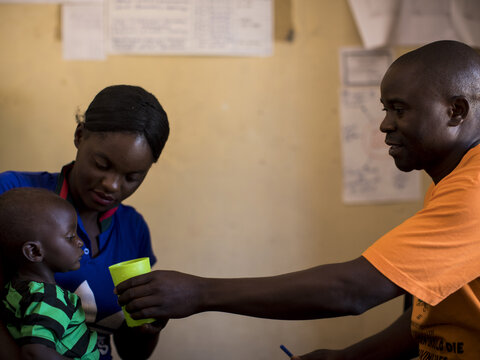Areas eligible for SMC and areas where SMC is implemented in 2021

|
Guinea: SMC 2021 season |
# of children targeted |
# of children reached |
Coverage |
|
Cycle 1 |
1,103,060 |
1,087,623 |
99% |
|
Cycle 2 |
1,103,060 |
1,119,775 |
102% |
|
Cycle 3 |
1,103,059 |
1,153,167 |
105% |
|
Cycle 4 |
1103059 |
1131587 |
103% |
|
Cycle 5 |
44518 |
41140 |
92% |
|
Children receiving at least 4 cycles |
1103059 |
1023165 |
93% |
Monitoring of coverage completeness

Monitoring for coverage
Geographic coverage and administrative office of the SMC is controlled by :
- The participatory approach with the community through meetings advocacy (local elected officials, leaders, etc.);
- Close supervision;
- Monitoring during and after the campaign;
- Interactive broadcasts through radio stations;
- Independent coverage survey at the end of the campaign;
- The triangulation of data through the daily verification of the number of children treated per team;
- The data quality control survey by cycle;
- Data synthesis and validation meeting at the district;
- A coverage survey was also carried out in 2020
Monitoring for compliance
- Prefectural and sub-prefectural advocacy meetings before each visit;
- Monitoring during and after each passage / independent monitors and campaign supervisors;
- Community survey by supervisors at all levels
- Organization of interactive radio broadcasts;
- 2021 post-campaign coverage survey
Monitoring for effectiveness
- Monitoring of malaria morbidity and mortality in children under 5 in SMC areas vs non-SMC areas;
- Collection of community opinions on the effectiveness of SMC during household surveys and monitoring.
Successes, opportunities, challenges and solutions
Successes
- Adaptation of key messages of SMC to COVID 19 context;
- Achieving the programmatic objectives of SMC by cycle (Macro and microplanning);
- Capacity building of stakeholder Implementation ;
- Administration of SP + AQ by mothers / caregivers;
- Provision of actors with protection kits against COVID - 19;
- Community buy-in;
- Sufficient availability of inputs and on time;
- Establishment of case management committees to manage delays ;
- The involvement and motivation of all stakeholders involved;
- The combination of SMC with other interventions.
Actions to take
- The scaling up of ICT4D digital technology;
- Supervise the taking of the last two doses of AQ;
- Extend SMC to other eligible districts;
- Institutionalize the association of other interventions (vaccinations, IPT, LLINs, case management) to the SMC campaign.
Challenges
- High workload of distribution teams in the context of pooling
- Staffing of agents with pooling inputs
- Challenges in ensuring quality implementation of SMC 22 with CD LLIN 22
- Avoid interference during SMC campaigns
- Improve the process of payment of actors by OM to avoid delays in payment
Proposed solutions
- Support for a third agent in each team
- Plan the consumption of pooling inputs in orders from health centers
- Prioritize SMC areas in Part 1 of the Milda campaign scheduled for May 2022
- Revitalize the consultation framework with the other programs and communicate the dates of passages in time
- Strengthen the pooling of other interventions and SMC
- Increase the number of staff for the rapid processing of requests
- Ensure good planning
- Send payment documents at least 7 days
Research priorities for 2021
- Ethnographic study on the determinants of SMC in Siguiri and Kankan
- Impact and cost-effectiveness study of a 5th visit to Dabola
- Evaluation of the impact of SMC on malaria morbidity and mortality indicators
Partners
- The Global Fund
- Catholic Relief Services
- The London of Hygiene and Tropical Medicine
- KOICA